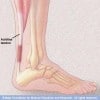Achilles Tendinitis

Achilles tendinitis is a condition that causes pain along the back of the leg concentrated near the heel. The Achilles tendon has its point of atachment at the posterior aspect of the heel. As the largest tendon in the body, the Achilles tendon connects the posterior calf muscle to the heel bone.it is also integral to balance and posture The tendon transmits force/power from the hips and legs to the foot. Due to how often it is used the tendon is prone to tendinitis and/or tendinosis.
Explanation
Tendinitis is the inflammation of a tendon and a natural response to injury or disease. There are two types of Achilles tendinitis that are defined by which part of the tendon is inflamed. Tendinotis is actually a misnomer as microscope studies of this problem hace not always shown inflammmatory cells. Rather it is more approriate to say tendionosis. A more accurate description is “tendinosis,” which is actually more degnerative than inflammatory.
Noninsertional Achilles Tendinitis: In this form of tendinitis the fibers in the middle portion of the Achilles tendon have begun to degenerate, thicken and swell. This typically affects young active people, but anyone may hace this problem. The area above the bony insertion becomes very thick and painful. Often a lump forms on the tendon and can be very painful.
Insertional Achilles Tendinitis: This form of tendinitis affects the upper portion of the heel where the tendon attaches to the foot. In many cases bone spurs form within the tendon itself with this type of tendinitis. Insertional Achilles Tendinitis can affect most people at any time, even if they aren’t active. It may be genetic or age-related. This condition often occurs in conjuction with a “pump bump,” which is a bone deformity on the upper portion of the back of the heel bone.
Cause
Achilles Tendinitis typically occurs from repetitive stress to the tendon. Whenever we overload our body’s ability to heal itself from normal daily trauma or increase the intensity of exercise to soon we’re more likely to develop tendinitis. Other influences can lead to tendinitis as well:
- Rapid increases to the intensity or frequency of activity
- Having tight calf muscles and implementing a rigorous workout program
- Bone spurs, which can rub against the tendon
- Change in foot wear
- Medical conditions such as DM or autoimmue disorders
- Immobilization and deconditioning
Symptoms
Symptoms include pain and stiffness along the Achilles tendon in the morning that increases during activity. Many patients report that their Achilles tendon thickens and swells throughout the day. Many people actually feel better as the tendon warms up and they use it. Once the tendon is inactive for an extended period of time the pain may return.
Treatment
Nonsurgical treatment will help sufferers with pain relief. The pain may continue for 3 to 6 months before treatment methods can be effective. Rest can be the first step in reducing pain. Low-impact activities can make the pain less intense and allow athletes to maintain their exercise programs. Sometimes all that is required is a 1-2 centimeter heel lift in the shoe. This takes enough force off the tendon insertion to reduce pain. Insertional achilles tendinosis also causes pain with pressure at the back of the heel. Open back shoes or structural flip-flops help.
A physician or trainer should guide you in terms of activity levels. Often a simple 1.0-1.5 cm heel lift can reduce forces on the tendon enough to grant pain relief.
Placing ice on the most painful area of the tendon for 20 minutes at a time can be helpful in easing pain. Ibuprofen, naproxen and other drugs can also reduce pain and swelling. There are also a number of exercises and stretches that can ease pain. The mainstay of treatment for this condidtion is physical therapy . There are very specialized treatment protocols for this common condition that work very well. Physical therapy is a mainstay of treatment. This treatment will vary from dry needling and massage to eccentric loading routines (otherwise known as Alfredson’s protocol).
Patients should only consider surgery if pain persist after an adequate courseof nonsurgical treatment methods. The type of surgery a doctor will recommend depends on where the tendinitis is concentrated and how bad the damage is.Also, the post-operative recovery and therapy protocol varies among surgeons.
For more information about Achilles Tendinitis visit the




